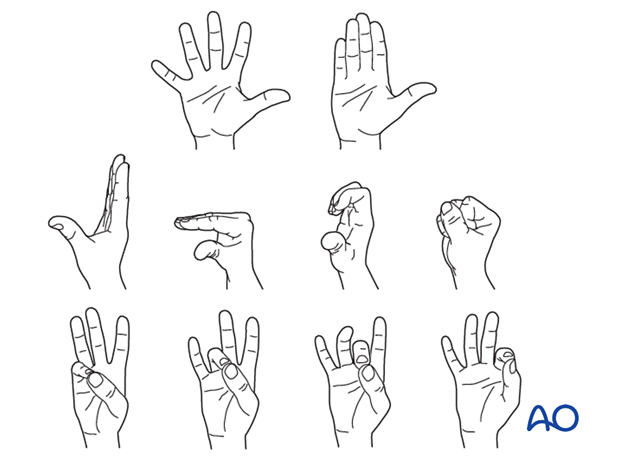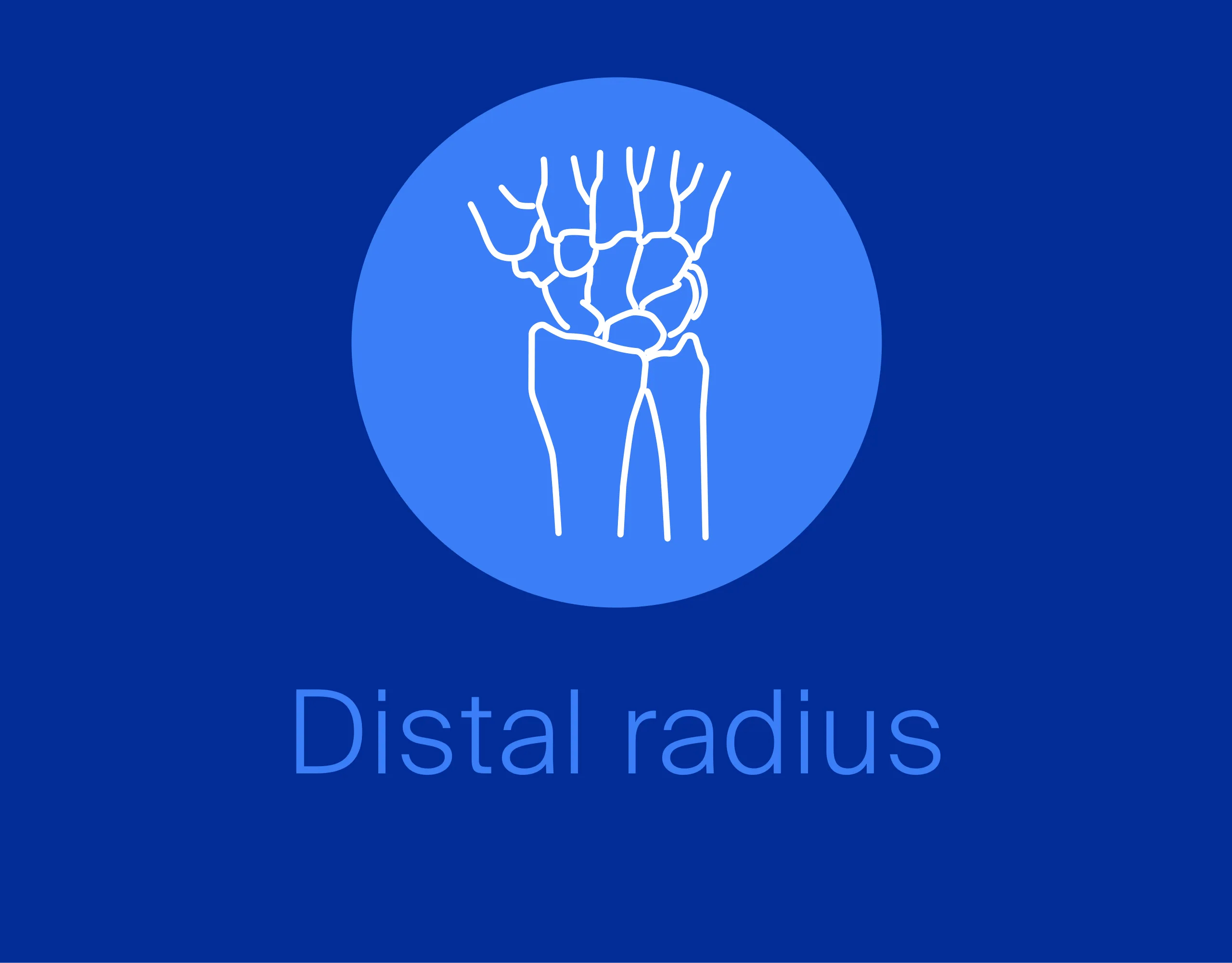Volar plate reattachment
1. General considerations
Suture anchors or bone tunneling
Two alternative techniques are available for volar plate reattachment: suture anchors or bone tunneling.
The advantage of suture anchors is the relative ease of the procedure. It is also a time-saving technique.
Tunneling is the more demanding procedure, but it is significantly less expensive.
The procedure may be performed with the patient awake with local anesthesia (WALANT). This allows active movement to check the tension of the reattachment by active flexion and extension intraoperatively.
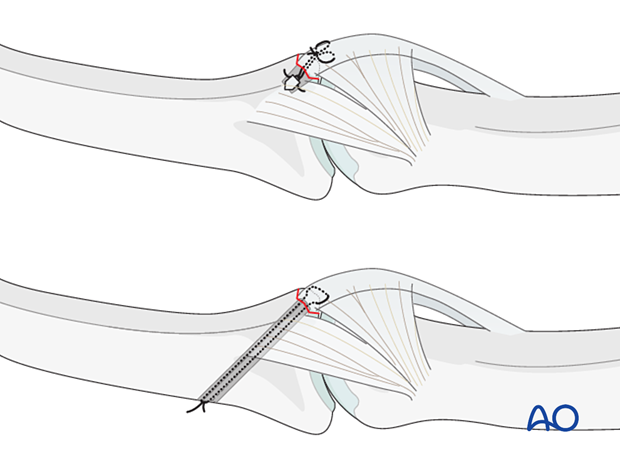
Recovery process
The recovery process after such injuries is slow. Advise the patient to expect 6–8 months for full recovery.
There is a high rate of contraction retraction with these injuries.
2. Patient preparation
Place the patient supine with the arm on a radiolucent hand table.
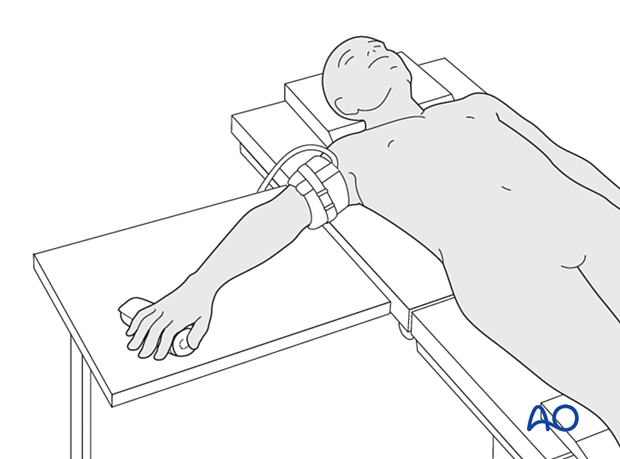
3. Approach
For this procedure, a palmar approach to the PIP joint is normally used.
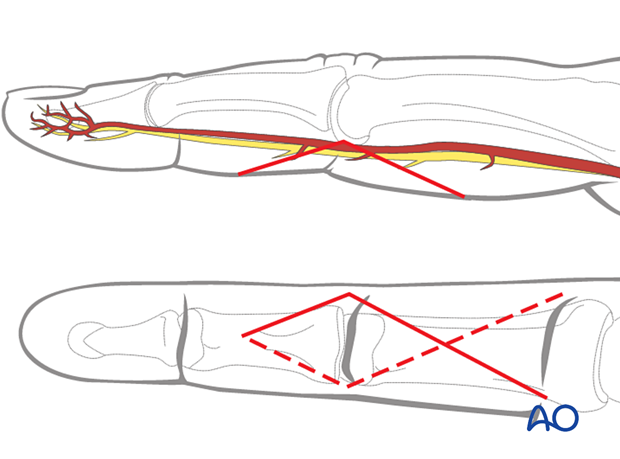
4. Reduction of dislocation
Closed reduction
Dislocation usually presents as an extension displacement with dorsal deformity.
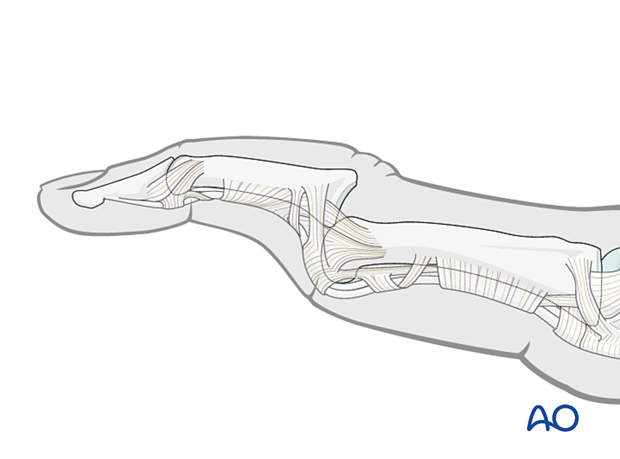
This can be reduced by increasing the deformity with gentle dorsally applied pressure on the middle phalanx to reduce the joint. This keeps the palmar structures in tension and reduced the risk of soft-tissue interposition.
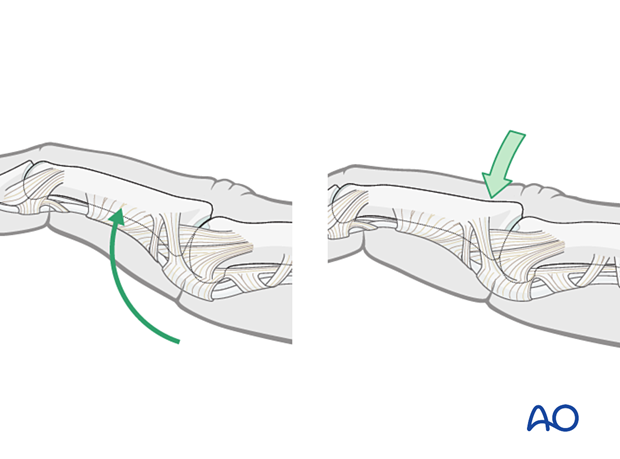
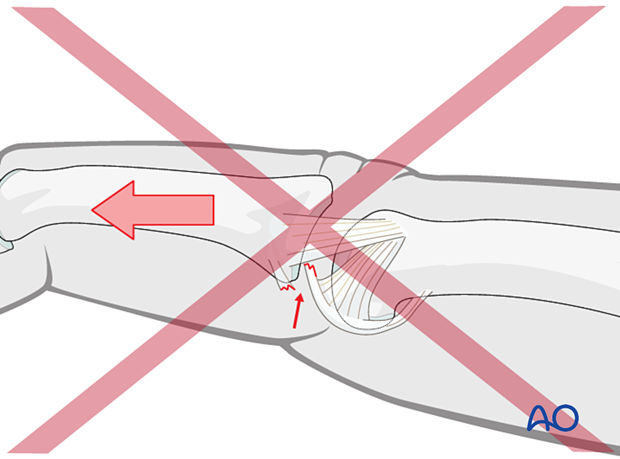
Stability evaluation
Confirm reduction with an image intensifier and check the joint stability by active flexion and extension and passive varus/valgus stress test. This should show congruent movement compared with the adjacent joints.
If this is the case, no further operative treatment is necessary.

5. Open reduction and repair of interposed tissues
Indications
If any widening of the joint is visible, soft-tissue interposition, usually of the lateral band, may be the cause.
In this case, the condyle is trapped between the lateral band and the central slip (a so-called “buttonhole” lesion).

Management
If the lateral band (or, more rarely, the central slip or the collateral ligament) is trapped in the joint, use a dental pick to free and reduce it, while keeping the PIP joint in flexion.
Subsequent repair is often necessary.
Use 6.0 nonabsorbable monofilament nylon to repair the injury with interrupted sutures as illustrated.

6. Visualizing the joint
Hyperextend the middle phalanx to gain a maximal view of the joint.
Assess fracture geometry and look for comminution or impaction, which may not be apparent from the x-rays and can only be determined under direct vision.
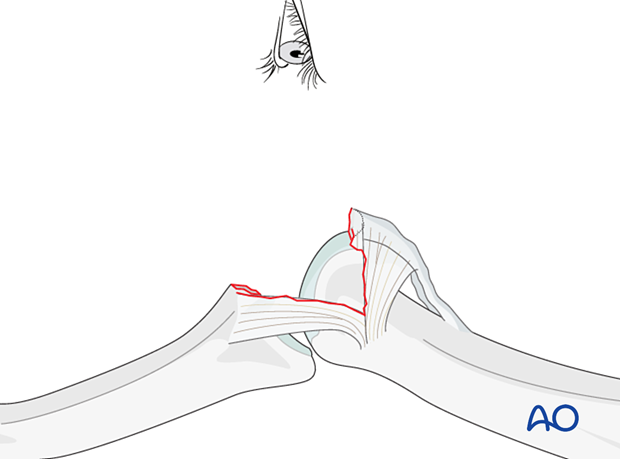
7. Option 1 – Suture anchor fixation
Drilling an anchor hole
Keep the PIP hyperextended to visualize maximally the area of the fracture at the base of the phalanx.
Use the appropriate drill to prepare a pilot hole for the anchor.
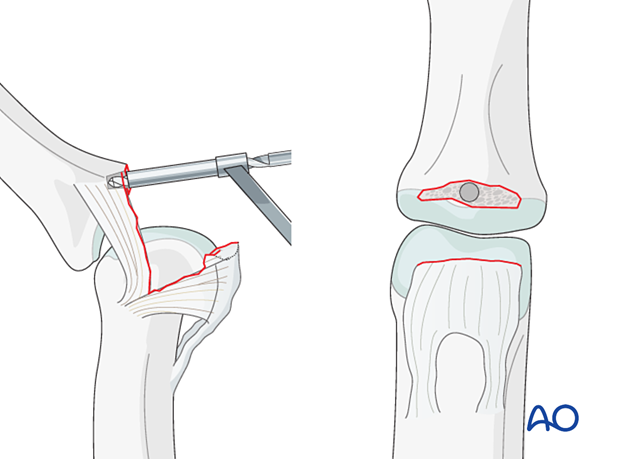
Insertion of the anchor
Insert an anchor with appropriate size according to the manufacturer’s instructions at the isometric point of insertion.
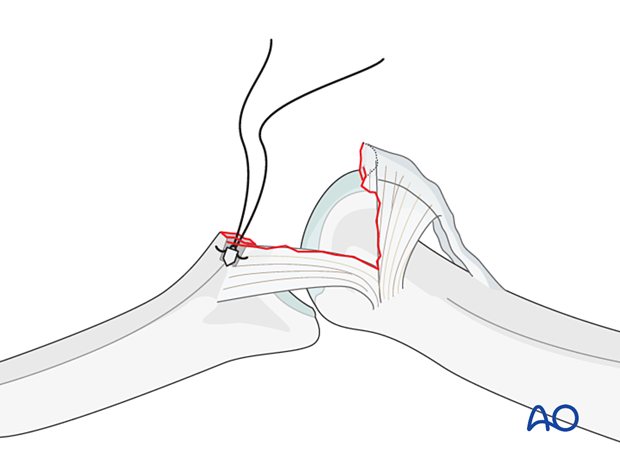
Insertion of sutures
Insert the sutures into the free end of the volar plate.
Reapproximate the ligament to the phalanx and make a loop in each end of the thread as an anchoring pass. Tie a knot to secure the volar plate to the phalanx.
Reattaching the volar plate close to the subchondral bone will ensure a smooth surface for ideal mobility.
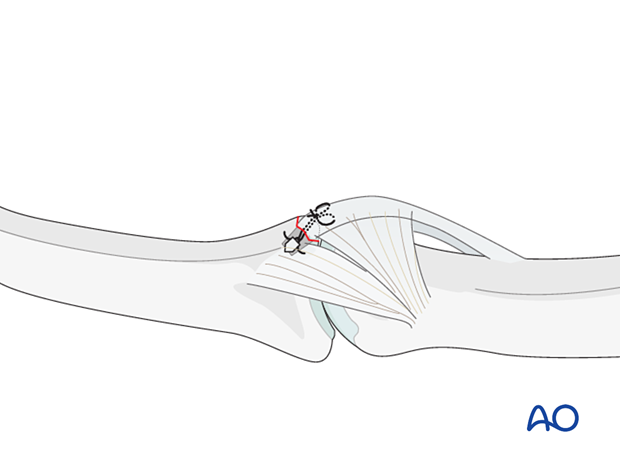
Alternative: fixation with two suture anchors
If the size of the fragment allows, two suture anchors can be used.
Choose anchors corresponding to the breadth of the fracture.
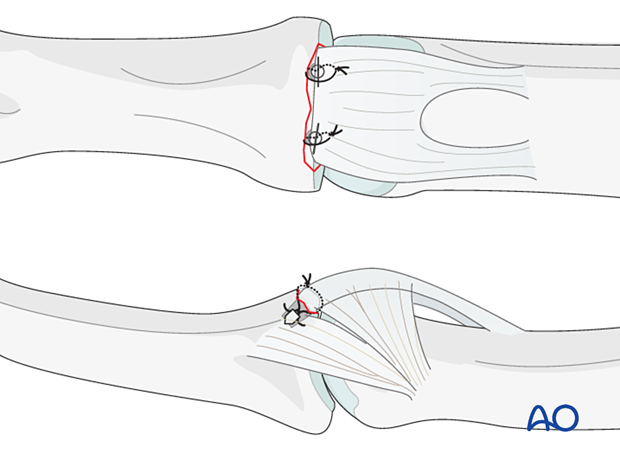
8. Option 2 – Bone tunneling
Drilling
Keeping the phalanx hyperextended, drill holes for the needles in the ulnar and radial sides of the base of the middle phalanx.
Each drill hole must be placed halfway between the palmar and dorsal edges of the fracture surface
A drill sleeve for soft-tissue protection is mandatory.
The drill holes must perforate the dorsal cortex of the middle phalanx.
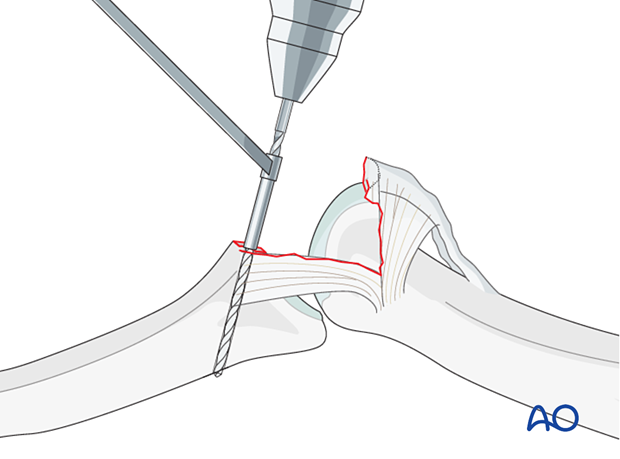
Always choose the diameter of the drill holes corresponding to the width of the small, avulsed fragment.
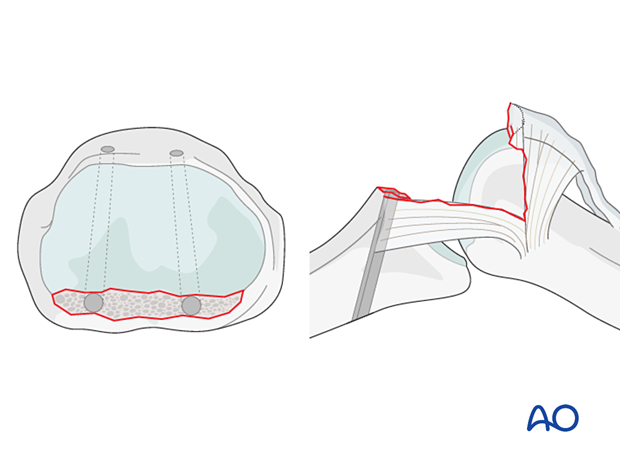
Dorsal incision
Make a dorsal incision of about 1 cm, distal to the insertion of the central slip, incising the triangular ligament.
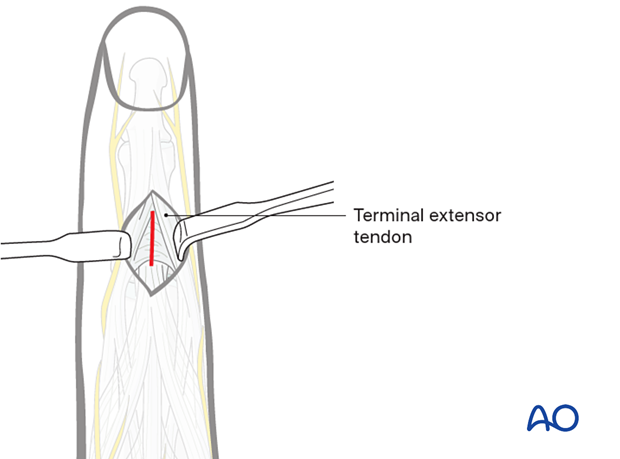
Insertion of the sutures
Use 4.0 braided nonabsorbable sutures with double-mounted straight needles.
Wrap each suture around the small fragment attached to the volar plate and insert the two ends of each suture through its drill hole. Both needles should exit dorsally through the skin incision.
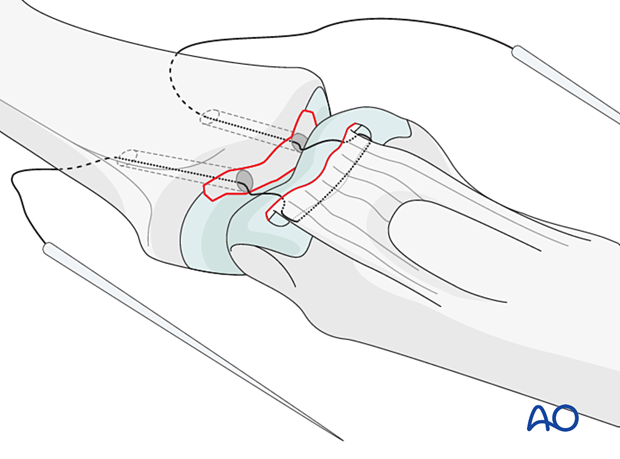
Fracture reduction
Gently reduce the fracture by pulling on the sutures in a dorsal direction.
Confirm anatomical reduction using image intensification.

This video shows the moment of reapproaching the volar plate to its distal insertion by pulling the sutures through the drill holes.

Tightening the sutures
After confirming that the volar plate is not too short, and that fixed flexion does not exceed 30°, tighten the sutures over the dorsal cortex of the middle phalanx.
Resuture the triangular ligament, if possible.
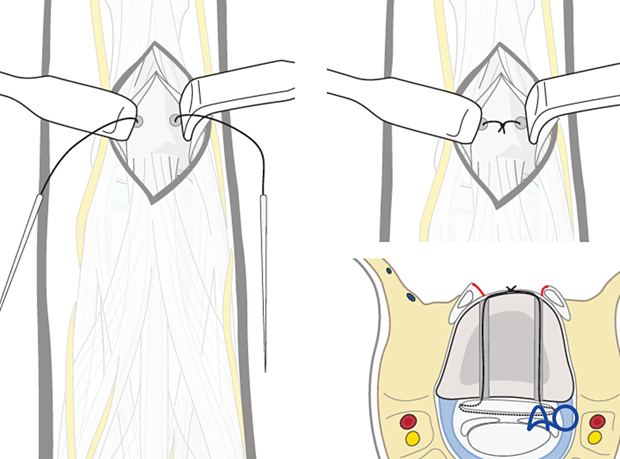
9. Joint transfixation with K-wire
Transfixation of the joint for 4 weeks may help to protect the ligament repair. There is an increased risk of joint stiffness.
Pass a 1.2 mm K-wire obliquely across the PIP joint with the joint in 20°–30° of flexion. This position protects the ligament reattachment.
Leave the end of the K-wire outside of the skin to facilitate later removal.
The fixation should be protected with a splint to reduce the risk of wire breakage.
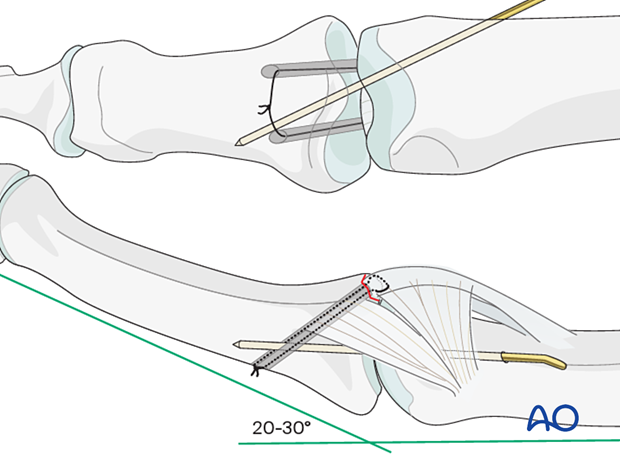
10. Final assessment
Check the stability of the fixation by extending the PIP joint.
11. Aftercare
Postoperative phases
The aftercare can be divided into four phases of healing:
- Inflammatory phase (week 1–3)
- Early repair phase (week 4–6)
- Late repair and early tissue remodeling phase (week 7–12)
- Remodeling and reintegration phase (week 13 onwards)
Full details on each phase can be found here.
Postoperatively
The hand is supported with a dorsal splint for 4 weeks. This should permit movement of the unaffected fingers. The arm should be actively elevated to help reduce the swelling.
The hand should be immobilized in an intrinsic plus (Edinburgh) position:
- Neutral wrist position or up to 15° extension
- MCP joint in 90° flexion
- PIP joint in extension

The MCP joint is splinted in flexion to maintain its collateral ligaments at maximal length to avoid contractures.
The PIP joint is splinted in extension to maintain the length of the volar plate.

Follow-up
When a K-wire has been used, it is removed after 4 weeks. X-rays are taken to confirm articular congruency. Unlimited flexion is encouraged after wire removal.
In the middle phalanx, the fracture line can be visible in the x-ray for up to 6 months. Clinical evaluation (level of pain) is the most important indicator of fracture healing and consolidation.
A palmar thermoplastic night splint, with the PIP joint in full extension, is used to avoid flexion contraction.
Active flexion of the PIP joint is initiated by using a dorsal extension block splint at 30°. This will need to be delayed until any K-wire has been removed.
After 4 weeks, the splint is removed, and unrestricted active extension is permitted.
If active extension is still restricted after 5 weeks, then dynamic extension splinting is recommended.
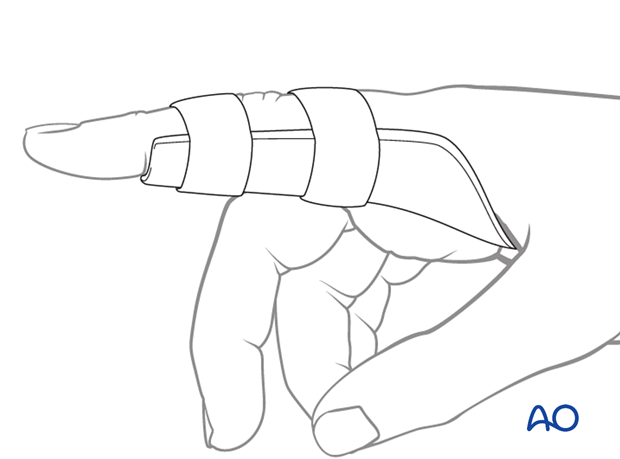
Mobilization
During the whole process, after removal of any K-wire, the hand therapist should closely monitor the rehabilitation.
DIP joint movement is encouraged immediately to avoid extensor tendon adhesion and joint stiffness.
Active mobilization is initiated after splint removal. Functional exercises are recommended.
Heavy manual load, whether domestic, occupational, or sporting, should be avoided for 3 months following operation.
